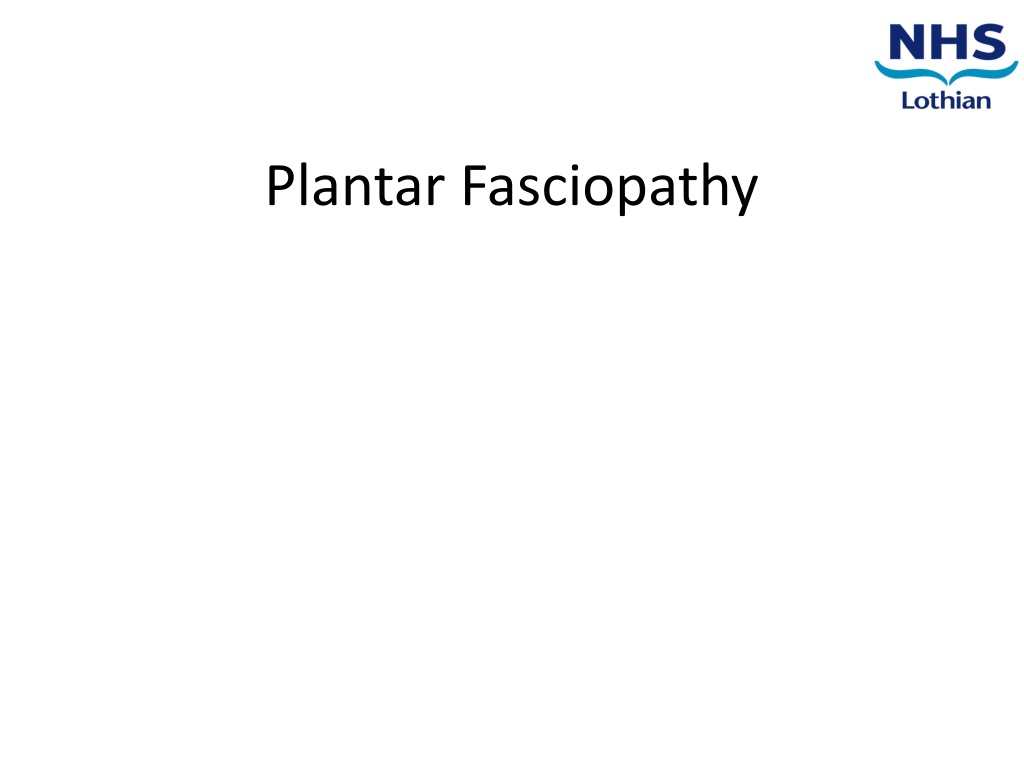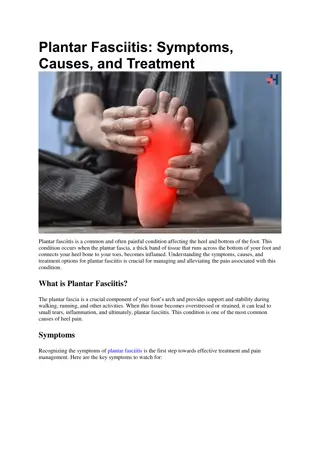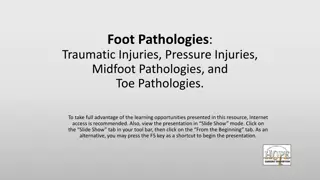Understanding Plantar Fasciopathy: Causes, Symptoms, and Management
Plantar Fasciopathy, also known as Plantar Heel Pain, is characterized by inflammatory or degenerative changes in the plantar fascia leading to heel pain. Causes include weight-bearing activities, tight calf muscles, obesity, foot mechanics, and comorbidities like diabetes. Symptoms involve heel and arch pain worsened by weight-bearing, especially in the morning. Diagnosis is based on a physical exam, and management includes self-care strategies, medication, lifestyle modifications, and professional interventions like podiatry and physiotherapy.
Download Presentation

Please find below an Image/Link to download the presentation.
The content on the website is provided AS IS for your information and personal use only. It may not be sold, licensed, or shared on other websites without obtaining consent from the author. Download presentation by click this link. If you encounter any issues during the download, it is possible that the publisher has removed the file from their server.
E N D
Presentation Transcript
Contents 1. What is Plantar Fasciopathy? 2. What are the causes? 3. What are the symptoms? 4. How is it diagnosed? 5. What is the management? 6. How can I manage it?
What is Plantar Fasciopathy? Plantar Fasciopathy is when there are inflammatory or degenerative changes to the plantar fascia resulting in pain. This is also described as Plantar Heel Pain.
What are the causes What are the causes? There are several proposed risk factors for Plantar Fasciopathy including; - Weight-bearing activity. -Tight calf muscles. -Obesity -Foot shape and/or mechanics. -Existing co morbidities e.g. Diabetes.
What are the symptoms? Pain in the affected heel which may extend into the arch Pain aggravated by weight- bearing activity. Intense pain during first few steps after a period of inactivity (particularly in the morning when getting out of bed). Tenderness over the heel.
How is it diagnosed? An appropriate healthcare professional will discuss your symptoms and enquire about your general health. A physical examination of your foot and ankle will be carried out to assess your movement, response to particular tests and level of pain. This conditions is diagnosed by clinical examination. In rare cases diagnostic imaging may be required.
What is the management? Many patients are happy to self-manage their symptoms, with painkillers/anti-inflammatory medication or other non-invasive treatments such as: Lifestyle and health changes Activity Modification Cold compress Rest and immobilisation, as required Self directed exercises Podiatry and/or Physiotherapy
Lifestyle & Health Changes Maintaining a healthy diet and weight Getting regular physical activity as per guidelines Getting 7-9 hours of quality sleep per night Reducing alcohol intake Quit smoking Not all of these recommendations will be relevant to everyone, but these are important factors to consider to optimise your outcome. Click this link for more information and support options
How can I manage it? Application of ice to control the pain/discomfort. Self directed exercises Rest/immobilisation/activity modification, as required - Example; if pain is caused by running, switching to an activity with less impact such as swimming may help or decreasing mileage. Simple pain relief or anti-inflammatory medication - Consult your GP or Pharmacist Well fitted and supportive footwear Image result for pain relief
Physiotherapy Physiotherapy/Podiatry Through a thorough examination, a Podiatrist or Physiotherapist can: Help you establish what may be causing your pain Provide you with an individualised treatment plan to help and/or resolve symptoms. This may include; -Foot and calf exercises. -Taping. -Footwear advice. -Foot orthoses/insoles. Advise and arrange further investigation, if required
More Invasive Management Options In some cases symptoms may persist and more invasive treatments may be required/requested by you, as the patient: Corticosteroid injections. Surgery.
Injection Corticosteroid injections - Steroid injections may help with pain relief by reducing the swelling/inflammation around the plantar fascia area. - Not everyone experiences a positive result with steroid injections.
Surgery Surgery is only required if pain is present and symptoms are unable to be controlled by more conservative methods, as described above.























